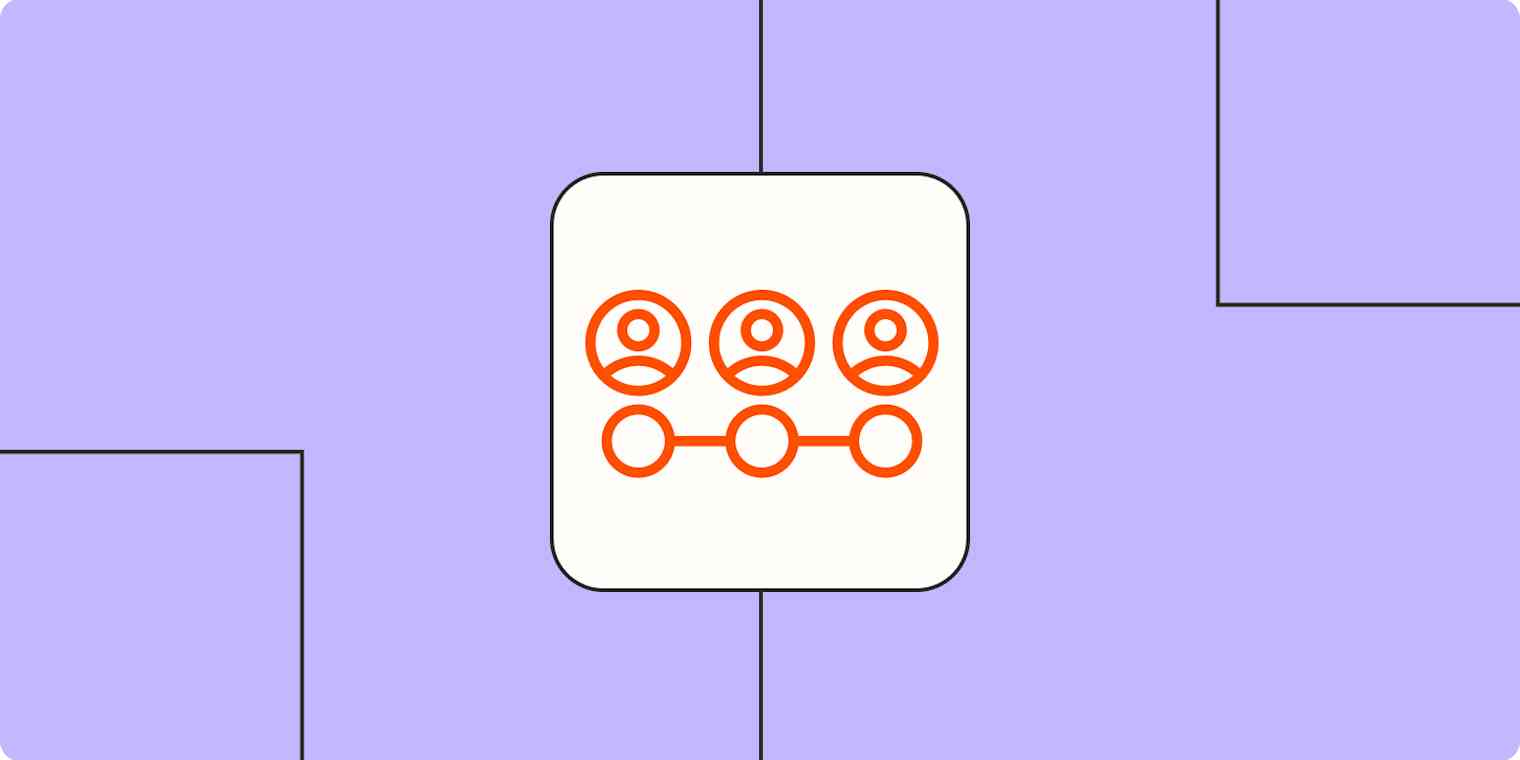Anyone who's lived in the high desert knows that weeds are no joke out here. Even though I'm a die-hard DIYer, I recently succumbed to hiring a neighborhood kid—I'll call him Dave—to rid my backyard of them.
When Dave posted flyers all over the neighborhood at the start of spring, I took the opportunity. The negotiable rate, mission to save for college, and cheery headshot complete with gardening tools and disposable surgical mask promised this would be safe, quality work for a good cause—all at value pricing.
What this industrious adolescent understood intuitively is the core of good business: a strong customer acquisition strategy that identifies a market, an opportunity, and a product tailored to both. Here's how to take a page from Dave's book and build an effective game plan for bringing in a sustainable stream of customers.
Table of contents:
What is customer acquisition?
Customer acquisition is the process of gaining prospective customers, nurturing them into leads, and then converting them into buyers. This flow, known as the customer acquisition funnel, has five phases: awareness, interest, consideration, conversion, and retention.
This strategy isn't to be confused with general branding and marketing tactics—those are parts of the process, but they aren't the whole thing. Customer acquisition is about a refined, thoroughly researched approach to identifying markets and actively moving potential customers down a sales pipeline.
In the example above, Dave was effective at acquiring customers because he had a strategy: offer homeowners a bad-back-saving service during peak weed-picking season. His flyers turned nearby homeowners into prospects, those prospects became leads when they texted him, and he was ultimately able to convert leads (like me) by selling us services we (or at least our backs) needed.

Benefits of building a strong customer acquisition strategy
Customer acquisition doesn't just happen on its own—the "if you build it, they will come" approach only worked in Field of Dreams because Kevin Costner had the help of baseball-playing ghosts. (I haven't seen this movie in over a decade, so don't fact-check me.)
In the real world, you need to proactively bring in leads. This kind of intention can bring benefits like:
Improved ROI: Targeted campaigns for customer acquisition allow you to focus on the campaigns, markets, and channels with the highest value and conversion rates.
Resource optimization: A defined strategy allows you to budget resources for predetermined tasks and campaigns. Over time, you'll see which acquisition channels are the most effective, allowing you to cut resources from the ones that aren't working.
Measurable progress: Because customer acquisition sets clear values on leads and conversions by corresponding directly to sales information, you can readily put real dollar amounts on successes and failures.
Visibility: As you nurture leads through the acquisition process, you can see where you're losing them in real time.
Sustainable growth: As you identify the acquisition strategies that work best, you can replicate them across products to steadily increase ROI.
Lower churn rates: Once you effectively and systematically acquire customers, you can perfect retention efforts. This allows you to proactively turn one-time customers into return customers—not just hope it happens on its own.
Visibility: The data you gain from monitoring customer acquisition campaigns shows you a massive amount of detail about your market and customers' buying behaviors.
What is customer acquisition marketing?
Customer acquisition marketing refers to marketing tactics that are intentionally geared toward converting current leads into customers. This differs from other forms of marketing because it involves strategically appealing to targeted potential customers with the end goal of progressing them through a predetermined acquisition funnel.
Traditional marketing plays a significant role in customer acquisition. It's how you build brand awareness, get your products and services in front of the eyes of potential customers, and grow a pool of leads.
What is the customer acquisition funnel?
The customer acquisition funnel refers to the general set of phases a potential buyer progresses through, from first impression through conversion. Another way of visualizing the CX lifecycle, this customer journey framework caters more to the business perspective of proactive lead targeting.
If you picture an actual funnel, those phases can be broken down into five milestones, going from the wide opening down to the skinny spout:
Awareness: The first phase in customer acquisition is building awareness for your brand, product, or service. This can be done through traditional marketing and publicity campaigns to build a preliminary pool of potential leads.
Interest: Not everyone who knows about your offering will find it relevant or be in a position to think about buying it. Those who do find it relevant to their needs or desires will become interested, making them leads.
Consideration: Leads with an interest in your offering who are theoretically ready and able to buy then move into the consideration phase. There'll be comparatively fewer leads here than at the start of the funnel, but at this point, they're nearly ready to purchase.
Conversion: Those who follow through with the purchase convert from leads into customers. This is obviously the primary goal, but it's still not the ideal end of their journey.
Retention: Satisfied buyers who stay interested in your products or services can then be retained so they continue buying from you.
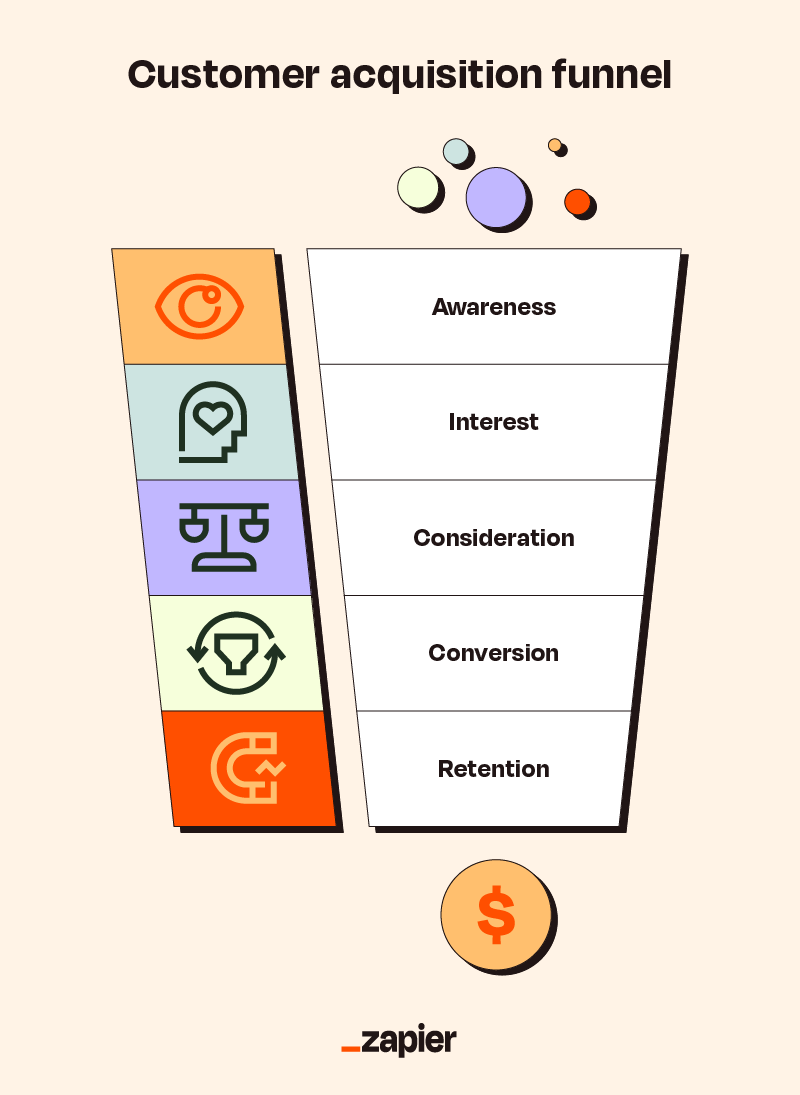
Here's what that funnel looks like for Dave and his yard services:
Dave builds awareness for his services by distributing flyers around a neighborhood primarily made up of middle-income homeowners.
By targeting homeowners with yards as the temperatures rise along with the grass and weeds, Dave generates interest.
As the weeds continue growing, the days get longer, and the mosquitoes start multiplying, interested leads start considering Dave's yard services.
Leads who get a quote convert when they pay Dave to come clean up their yards.
Dave retains customers when they see their weeds coming back during monsoon season when it's 101 degrees.
How to choose your customer acquisition channels
To acquire new customers, you need to be able to reach them on the right channels. This helps you define your market, refine your outreach strategies, and meet potential customers where they are.
Those channels can be broken down into two main types.
Digital channels: These will probably apply to just about every major business, while digital-first offerings like SaaS or cloud products may exclusively operate here. Common examples of these channels include:
Social media
Influencers
Blogs
Websites
Newsletters
Pay-per-click (PPC)
Traditional channels: While these can seem most applicable to physical or geographically-specific offerings like automobiles or yard services, many digital products can still gain a lot of traction from non-digital channels like:
Pop-up shops
Trade shows
Guerilla marketing
Physical advertising
Partnerships
Referrals
How do you know which ones are right for you and your potential customers? Start by following these four steps.

1. Audit your current channels
As someone wise (probably) once said, you can't know where you're going until you see where you're standing. In this case, that means taking stock of all your current channels.
Start by listing out all the places where you interact with customers or where they have touchpoints with you in some way. Include everything from your Instagram feed, blog, and Facebook ads to your annual trade show schedule, billboard advertisements, and Google Business profile. You may need to poll team members across sales, marketing, and even IT departments to get the full picture here.
Once you've listed your channels, compile performance metrics, so you can evaluate how active you are on these channels and how successful your efforts have been. Without getting too granular, here are some common metrics you can start with:
Traffic
Engagement
Backlinks
Conversions and conversion rates
Clicks and click-through rates
Impressions
Time on page/site
Ad spend
Operational expenses
Obviously, the metrics you use will vary widely by channel. The main thing is to get a holistic view of your current acquisition channels, so you can see where your resources are and aren't going.
2. Define your market
Knowing how to reach your market means first knowing who's part of it. Customer demographics and buying habits can have a huge influence on where they spend their time and attention, which in turn can tell you where they're likely to interact with businesses and find products.
Again, this is a very nuanced step in the process that can take a lot of time and involve multiple teams. Depending on where your product is in the sales process, your marketing, sales, and product teams may have already done much of this work. These processes can help you define your market:
Create detailed customer profiles.
Develop user personas.
Perform a competitive analysis.
Explore existing third-party market studies.
Find public demographic data from government agencies.
Initiate your own market research through surveys, focus groups, or customer interviews.
Like other steps in this process, this is a cross-functional (and potentially time-consuming) one. But it's well worth it to know everything you can about who you're trying to reach.
3. Identify which channels they use
It's probably not a great strategy to just start blasting your Twitter/X feed with promotional content because it's the only social media outlet you use. Rather than risk shouting into the void, you should be sure that there are real, engaged customers on the other end of it.
This is where your research in the last step comes into play. For example, a SaaS company may find that the busy, mid-career executive decision-makers they market to get recommendations from industry leaders on LinkedIn or conference panels. Meanwhile, a provider of trendy, nontoxic kitchenware should know that the stay-at-home middle-income parents they sell to get a lot of their cooking tips from influencers on TikTok and YouTube.
Data about which channels your potential customers use should come from market research, but here are some general tips on how you can find out which ones are important for reaching them:
Monitor where your competitors dedicate social media, advertising, and promotional resources.
Conduct customer surveys.
Search relevant hashtags across social media outlets.
Explore your own website analytics to see which sources drive your traffic.
A/B test campaigns across multiple channels.
Read through Reddit threads related to your industry or competitors to see which channels they commonly mention.
Use keyword research to see which channels are brought up alongside search terms that are relevant to your product.
Look up Google Trends data on key terms related to your product and industry to see what potential customers are interested in.
Remember that trends in channel usage can change quickly. Reports, anecdotal experience, and campaigns that are just a few years old could be completely out of date today. If you can identify trends in your market's behavior and plan around them before your competitors catch on, you could create a major competitive advantage.
4. Decide which channels are viable for you
Once you know who your market is and which channels they actively look to for product inspiration, you can combine each of the three steps above to find out how to adjust your efforts. Ideally, your Venn diagram will show that your market's channels overlap with many of yours. Even if it doesn't, the information should be illuminating about where you should look to grow your presence.
Keep in mind that this data doesn't have to be 100% prescriptive. For example, it may not make sense for a virtual legal services upstart to try to compete with giant law firms' localized network advertising campaigns since they have no name recognition or physical offices. Meanwhile, a growing funeral services provider might find that their competitors aren't active on Instagram, but creating tastefully funny Reels aligns with their unique angle of bringing levity to their market of older millennials with aging parents.
Deciding on channels is one part data, one part art. Your research from the previous steps should give you a real idea of what the norm is for your market and industry. That data may also point to trends that haven't actualized yet; now that we all accept TikTok's explosive growth, we can see the writing was on the walls in 2019 when people had an insatiable appetite for short, candid, personal video clips and synchronized dancing.
Having a baseline about what your potential customers expect can't tell you what makes sense for your product, brand, growth goals, and unique selling point. You'll also need to consider factors like these before you dive blindly into every channel your competitors and market use:
Marketing budget
Level of brand awareness or industry authority
Marketing personnel and bandwidth
Alignment with broader company goals or timelines
Time to value for efforts in each specific channel
Cost to keep up with established competitors
Scalability
Any potential regulatory or compliance obstacles
Remember that any channel will take time and planning to see through to success, but the last thing you want to do is waste valuable resources on channels that don't come to fruition soon enough. Before you make any decisions, set specific goals for each channel so you can measure success over time and be sure you've made the right choices.
13 customer acquisition strategy examples
Strategy | Sales funnel position |
|---|---|
Content marketing | Awareness |
Search engine optimization (SEO) | Awareness |
Social advertising | Interest |
Pay-per-click (PPC) search advertising | Interest |
Referral programs | Retention |
Partnerships | Awareness |
Webinars and workshops | Consideration |
Influencer marketing | Awareness |
Email marketing | Consideration |
Free trials or freemium models | Conversion |
Gated resources | Interest |
Customer reviews and testimonials | Retention |
Social engagement | Retention |
You know your market, you've got your channels, and you're ready to start moving all those customers along the acquisition funnel—now it's time to plan your campaigns.
Consider these customer acquisition strategies from across channel types to find and convert new leads.
1. Content marketing
Content marketing takes many forms: blog posts, infographics, videos, white papers, original survey data, and podcasts. All of these can play a role in customer acquisition.
What's great about content marketing is that it gives everybody value. Users get information or entertainment (and if you're really doing it well, both), often for free. Meanwhile, marketers get to publicize a product, build brand awareness, create a definable touchpoint for creating leads, and monitor lead conversions. On the back end, marketing teams can track user behavior and create systems of content that naturally progress toward high-value actions like newsletter sign-ups, free trials, consultation scheduling, or product demo requests. They can then assign a real dollar value to those actions to get hard data on how successful their content is.
Case in point: you're looking at it.
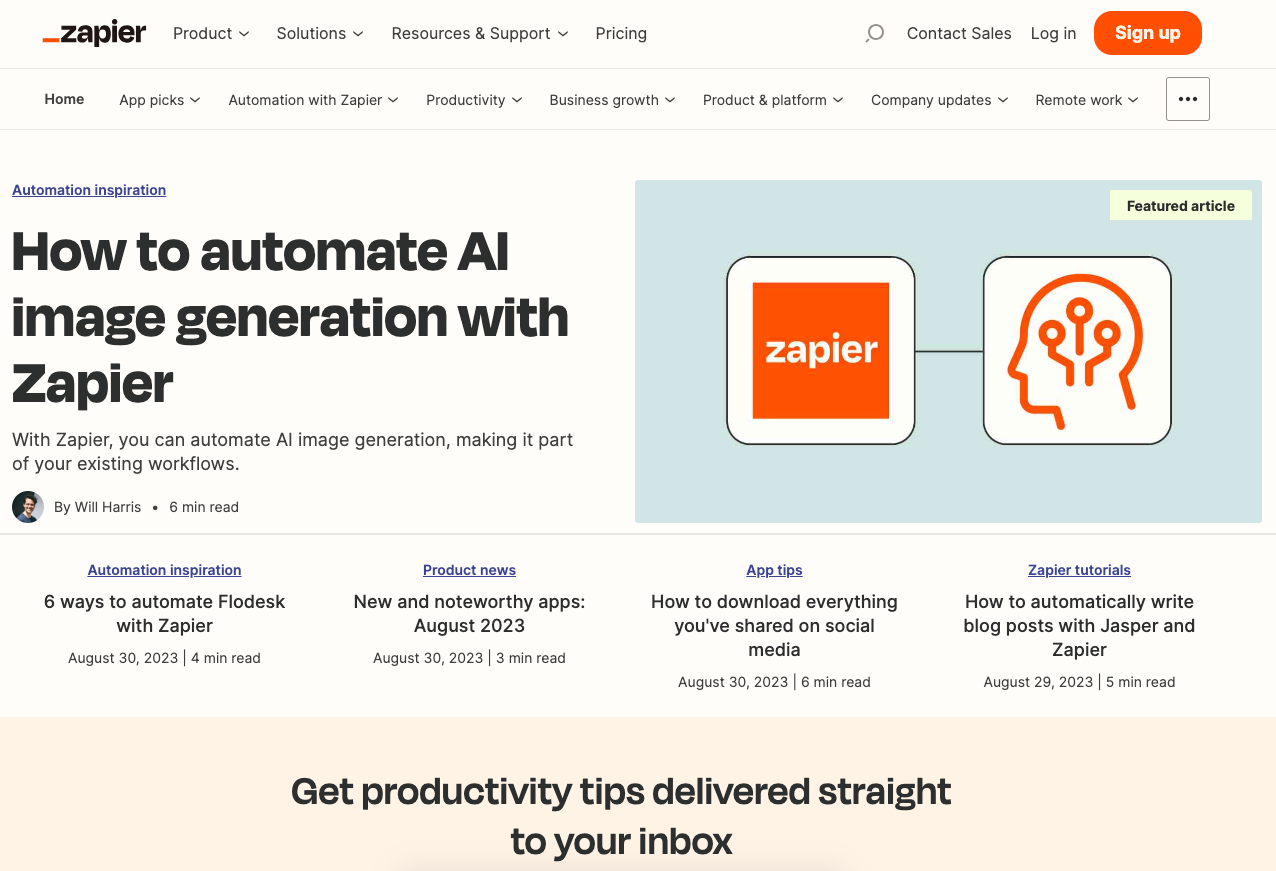
In case you haven't noticed, Zapier, whose blog you're on right now, is a strong proponent of content marketing. Each article on the blog goes through rigorous research and quality assurance, so end users get industry-leading tips, insights, guides, app comparisons, productivity inspiration, and templates—all of which either directly or tangentially relate to Zapier's product.
2. Search engine optimization (SEO)
For many businesses, their website is the foundation of the customer acquisition journey. It's where people become leads and where leads convert to customers. SEO thus goes hand in hand with many other customer acquisition strategies—especially content marketing.
SEO is intended to help your site rank higher on search engine result pages (SERPs), which means that sound SEO strategies help your content marketing efforts (and vice versa). SEO goes beyond just optimizing the copy with keywords, organizing the page structure so it's user-friendly, and filling in the metadata so it's optimized for crawling. It also means setting up your entire website—from the domain/subdomain structure to the navigation menu to the loading speed—for optimal user experience.
If you search for your general product or service type, chances are the first result in the SERP has top-notch SEO execution. For example, when I search Google for "basketball shoes," it's no surprise that Nike.com's basketball shoes page pops up first.

This is a site with a ton of products, images, and pages, and it still loads before I can say "Air Jordan XXXVIII Fundamental" three times fast. The URL of its Mens Basketball Shoes page doesn't have a ton of unnecessary categories or subdomains, the top nav has six simple options, and there are no distracting pop-ups or fancy effects detracting from my user experience. The title tag and description are concise and clearly optimized for the keyword "men's basketball shoes" without getting all keyword stuffy.
At the bottom of the page, below all the beautiful sneakers, there's even a "Related Stories" section to keep sneakerheads moving through the website. Featuring product launch details, news, and buying guides like "The Top 5 Nike Gifts for Teen Boys," its (also clearly keyword-optimized) content pages support its shop pages by directing traffic back to relevant product lines. By keeping its SEO game as tight and clean as a pair of brand-new Jordans, Nike can draw general, brand-agnostic customers to its website before competitors have a chance to do the same.
3. Social advertising
The strength of social media advertising is precision. Once you know which platforms your market uses, you can zero in on exactly who you want to reach based on demographic info like age, interests, location, and even online behavior. If you sell automotive accessories, you can home in on users who like cars. If you sell image editing software, you can display your ad only to people listed as graphic designers.
Another perk to social advertising is that you can see what's working (or isn't) in real time. Each platform's ad hub should show you updated data on impressions, clicks, conversions, and engagement so you can fine-tune your messaging at a moment's notice. If something's not clicking, you can switch things up and see the impact right away. Or, you can A/B test across demographics or platforms to see where your money is best spent.
To illustrate, let's get meta: LinkedIn doing LinkedIn advertising on LinkedIn.
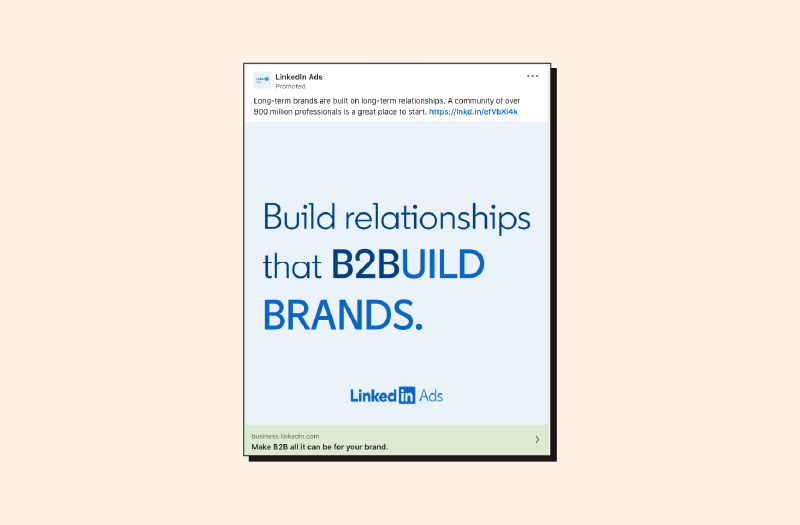
If anyone knows who uses LinkedIn and how to market to them, it's…LinkedIn. While many types of people use the channel, it's clear that the ad is targeting the ones who actually have the need (and funds) to execute long-term campaigns. High-level decision-makers who oversee B2B relationships can see this through the ad, too. The value proposition is clear (build your brand), and so is the call to action (advertise to over 900 million professionals) with no wasted words or images. It gets down to business because that's exactly what its audience is on the website to do.
The link goes to a LinkedIn Business Solutions landing page for the B2BUILD campaign, where users-turned-leads are walked through the advertising hub. On the back end, LinkedIn's marketing team can see how users who land on the page interact with it to find where they're losing leads, the rate at which leads convert into customers, and data for calculating the return on their advertising investment.
4. Pay-per-click (PPC) search advertising
Pay-per-click advertisements are the little ads that pop up in various spots within search results that relate to your search query.
Like social media advertising, PPC advertising has the benefit of being able to target leads. You also only pay when a potential lead actually becomes a real lead by clicking your ad. Within your ad hub, you can see how your ads are ranking compared to competitors', how many total impressions they're getting, and how often they're getting clicks. By setting up dedicated landing pages to link these ads to, you can even track the exact conversion rates of leads who arrive via your PPC ad.
With this level of analytical detail, you get real proof of how effectively you're both acquiring leads and converting them into customers.
For successful campaigns, you can justify increased spend with real dollar values. If you detect low lead acquisition rates, you can easily A/B test your creative and target keywords, try new keywords, or increase your budget. If you're getting plenty of clicks but are seeing low conversion rates, you might change your landing page, add more CTAs, A/B test copy, or tweak the page and structure.
To illustrate, here's how Article stuck out for the search term "leather couch":
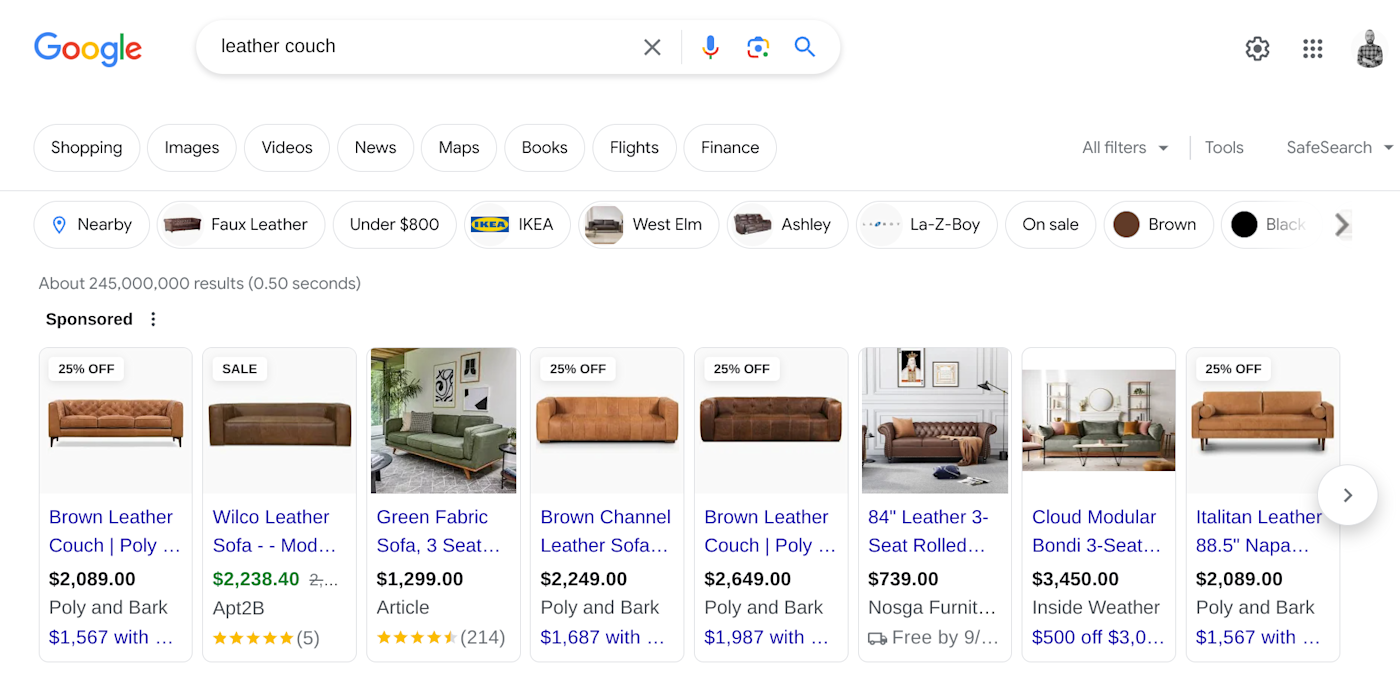
Visually, this was the first result I noticed in the carousel of PPC competitors. In half a second, I see an attractive couch that stands out, I know what it costs, and I know buyers like it, which is essential since I can't give it a nap test first.
Clicking the link takes me, as I'd predict, to its product page, where all details look exactly as I expect based on the PPC ad. I can also see in the URL structure there's a tracking tag after the product URL that ends in source=google. That tells me Article is tracking the performance of its PPC ad by monitoring who comes to the page via that ad. This allows the company to see if what it costs for me (and other potential customers) to click pays off with a $1,299 sale.
5. Referral programs
Generations of sales teams have used referral programs to acquire customers, and there's a reason they're still in use: they work. The beauty of a referral program is that it taps into the resource of existing satisfied customers, setting up a quid pro quo for them to bring in new customers or users.
The specific incentives depend on what you're offering, but typically come in the form of one or more of these:
Discount codes
Free gifts
Account deposits
Free trials
Free subscription periods
Promotional points
Free services
Free upgrades
A prime example is fee-free stock trading platform Robinhood, which offers current users a free stock for referring new users, who also get a free stock.

This incentive is clever for two reasons: it aligns with Robinhood's offering and it encourages repeat referrals. According to the company's referral program guide, the cash value of the stock users get could be between $5 and $200. That means users see "$5" and think "free Tesla stock." When they likely get a single share of a stock they've never heard of that will hopefully appreciate by $0.50 in two years, they may feel compelled to keep up referrals for the chance at a high-value stock.
In the meantime, Robinhood benefits because it's acquired more vested users who are now depositing money into their accounts to buy the next big stock du jour. And since stocks are typically long-term investments, it hooks long-term users, who have more time to continue depositing and referring more new users. It's technically a win-win, but I get the feeling Robinhood wins more than most users.
6. Partnerships
Need to acquire customers from a market segment that's been totally out of reach? Partnerships can help you do that. This win-win scenario allows your business to benefit from the name recognition and audience of a non-competitor related to your industry while giving them a way to do the same.
Home lifestyle brand Williams Sonoma has been very effective in choosing partnerships, especially in its family brands dedicated to kids. One such partnership is West Elm Kids and National Geographic.

This partnership helps National Geographic expand into a sector (home goods) it has no access to while giving several benefits to West Elm Kids, like promotion of its commitment to sustainability, which aligns with NatGeo's audience's interest in the environment.
Anyone who's ever made a collage in elementary school knows NatGeo has long been a fixture of American public education. Meanwhile, anyone who's ever bought toys, linens, and decor for kids knows that anything considered remotely educational gets a bump in parent approval ratings. A smart partnership (smartnership?) like this gives businesses like West Elm Kids a new avenue for acquiring customers that aligns with and expands its current market.
7. Webinars and workshops
Nobody knows your industry and product like you do. Sharing your knowledge with your market through free live webinars and workshops allows you to:
Home in on people in your market who are already hypothetically interested in your offering (who are now also pre-educated about its benefits)
Differentiate from competitors
Build trust with potential leads by showing your expertise, expressing empathy for pain points, and putting a human face to the brand
Build brand recognition by making a lasting impression
Collect marketing data like contact information
Qualify potential leads with more information
Position your offering as a solution to common problems your market faces
Learn more about people in your market by interacting with them
Piggy-back with additional research like surveys or interviews
Airtable, which offers a low-code app-building platform, does a great job of using this approach by hosting instructional webinars about topics related to its software's use cases.
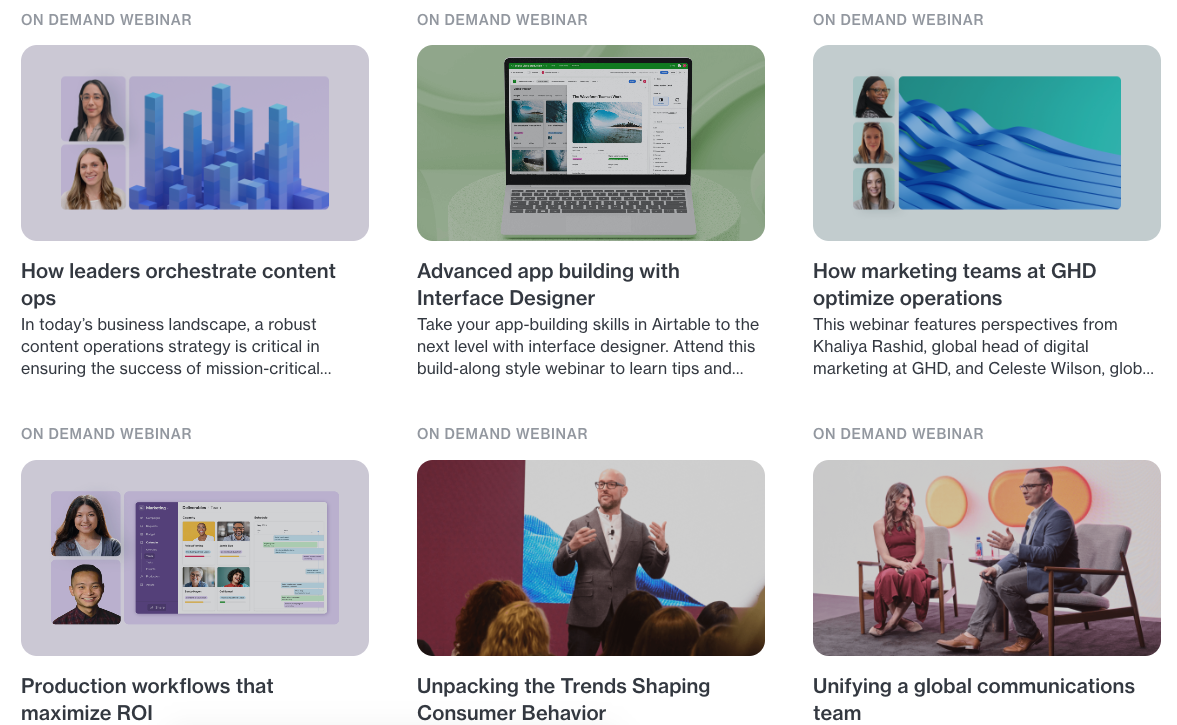
By educating the public on product features and broader subjects like product planning, workflow management, consumer behavior, and digital marketing through webinars, Airtable can give thought leadership on in-demand issues and then tie in its own product seamlessly. This allows the company to acquire high-value leads that are much more likely to become customers.
8. Influencer marketing
Scrolling TikTok, Instagram, or YouTube for literally any amount of time shows what makes influencer marketing so potent: even if these loosely veiled product placements littering your feed are a form of paid advertising, they still feel like carefully vetted recommendations from real, down-to-earth, not incentivized human beings.
Rather than carefully polished commercials playing on repeat, you're seeing interesting people excitedly telling you about how much they love a product. Once you see three or four of these over the course of a couple days, it starts to build the FOMO.
From a marketing point of view, this is hugely valuable. This is a genuine word-of-mouth product promotion you can pay for. While high-level influencers with millions of followers may charge for their services, smaller influencers will make videos for the cost of one free product or software license. Even amateur influencers' reviews could be read or seen by thousands of people, which is still a really strong return on a very minimal spend.
Here's what I'm talking about.
@coffeelicker No more looking like a turtle 🐢. Check it out at brevite.co/coffeelicker — #ad #camerabag #brevite #photography #filmmaking #cameragear @brevite ♬ original sound - Herman Huang
Herman Huang (@coffeelicker) is a creator whose content focuses on videography. This makes him a perfect paid partner (note the designation below the caption) for Brevitē, manufacturer of the multifunctional camera bag featured in the video pictured above. This video is nestled into his library of editing tips, software guides, and craft tutorials. As you're scrolling through original, non-sponsored content, it feels like just another original, non-sponsored video that happens to recommend a product.
With just over 7,000 followers, Herman was probably a relatively low-cost partner compared to celebrities or career influencers. However, he was a very targeted one with a dedicated following of exactly the kinds of people who would buy a Brevitē bag. Reaching out to creators like him (which the company's feed shows me it does often) allows Brevitē to reach highly targeted audiences with user-created content.
9. Email marketing
The great thing about using email marketing for customer acquisition is that it can be used in conjunction with many of the other strategies on this list. Free webinars, for example, can be used to generate new sign-ups for your newsletter, which can repurpose content created for your search-optimized website.
Typically, new customers will need to be incentivized to opt into your email campaigns with freebies like trials, white papers, reports, or demos. By keeping these leads engaged with your offering through your newsletter or pre-written drip campaigns, you can stay top of mind until they decide to make a purchase.
Going (formerly Scott's Cheap Flights) is a master of this—in fact, its business model is centered around email.
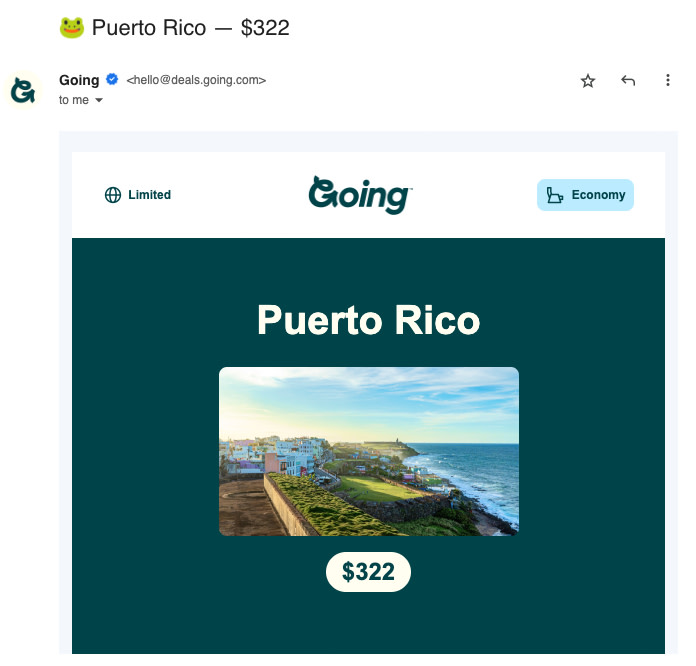
Going sends its free users like me cheap flight deals from all around the world. These are flights I wouldn't necessarily think to look up on my own, so it's fun to see them appear in my inbox periodically, so I can suddenly feel like I have the option to take an impromptu trip to Puerto Rico.
These emails are also vehicles for Going to sell its premium service—which, if I wanted a more bespoke cheap travel recommendation experience, I may be willing to pony up for. It also allows the company to advertise sponsors like Babbel, a language-learning app that's an obvious choice for an audience of international travelers.
10. Free trials or freemium models
I don't know who said it or where I heard it, but there's an adage I think about often: if something is free, you're the product. Free trials prove that to be true for sales teams.
But the saying is a little harsh in its cynicism. By offering potential customers a free trial of your product or a stripped-down freemium model, you do give them real value—either the free offering is all they need and they get to save money on something they would have paid for, or they get to test drive it before they buy. And from a sales perspective, both outcomes can be valuable.
The cable replacement streaming service Fubo is a prime example.
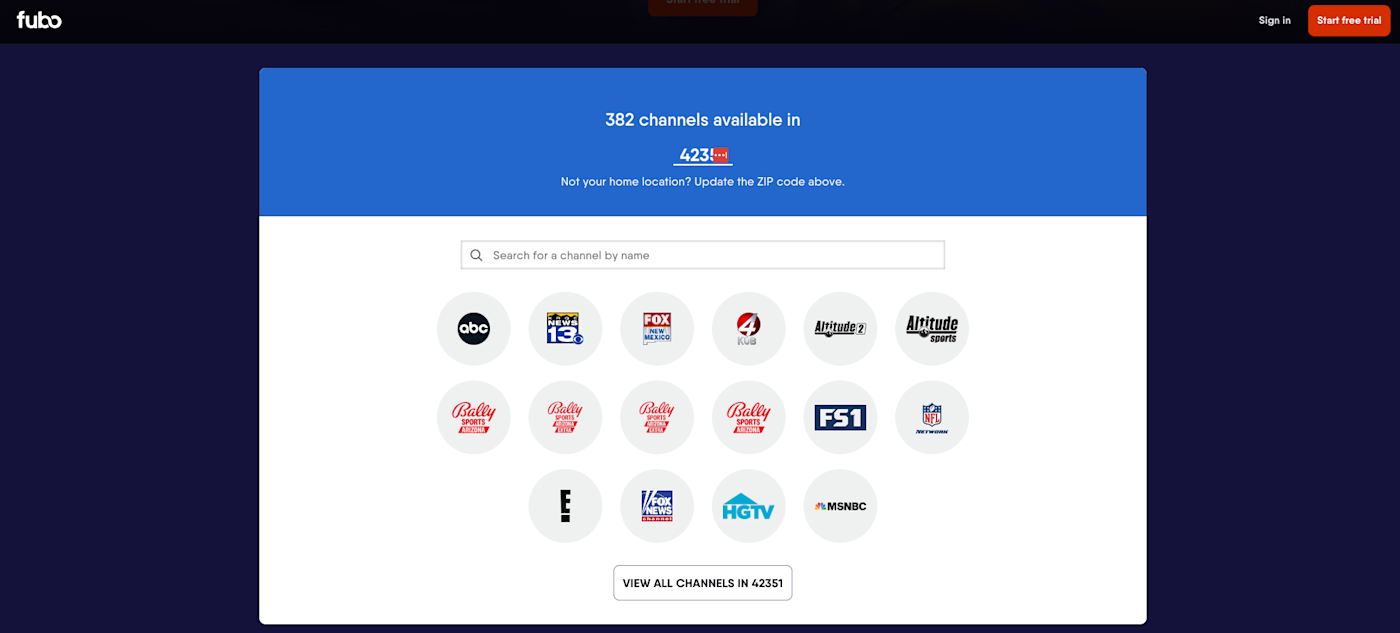
When I wanted to watch the Oscars this year, I realized the only way to watch it was to have a live TV subscription. The red carpet had already started, and I was running out of options because I hadn't had access to cable in about a decade. It turned out Fubo was one of the only streaming options with a free seven-day trial, which I started up just in time to catch Pedro Pascal being charming in a double-breasted Zegna suit.
11. Gated resources
When you have gated content on your website, you ensure the only way users can access it is by taking a step like entering their contact information to create an account or receive it via email. These contacts are extremely valuable because you know they fall within your target market and have enough interest to go out of their way for your resource. It also positions you as a trusted authority, giving you an edge over your competitors.
Once you have these contact details, you can proceed with other customer acquisition campaigns, like email campaigns containing free trials, discounts, product advertisements, and other offerings.
The key here is that it has to be truly premium content that goes above and beyond what's freely available on other blogs or websites around the web. Think proprietary information like case studies and survey data or high-level content like long-form eBooks, detailed white papers, or meticulously crafted templates.
Industry research provider IBISWorld has built its whole business on this model.

Good market research is hard to come by, and IBISWorld has it in spades—if you're willing to pay for it. However, interested users can start with a free trial report from an industry of their choice. It may not include the exact information they're looking for, but it gives a clear picture of the quality of data customers can expect.
To get that free sample report, you have to sign up using your work email and company name. (This no doubt contributes in some way to more proprietary data.) Once you do that, you may get your sample report and move on with your life, but IBISWorld can continue marketing its reports to you for as long as you keep them out of your junk folder. So even if you don't buy the full version of that report, you'll be more likely to come back to the company the next time you need premium industry data.
12. Customer reviews and testimonials
Once a lead becomes a happy customer, it doesn't have to be the end of the road for either of you. I'm not just talking about retaining them for repeat purchases (more on that later)—I'm talking about using their experience to bring in new customers.
These days, I buy almost nothing without checking reviews first, and with so much competition out there, your customers are probably the same way. Encouraging your buyers to leave reviews or create testimonials can be a great way to both improve their loyalty to your brand and improve overall acquisition rates. Similar to influencer marketing, these written or recorded reviews show potential customers what real customers love about your offering by highlighting the features that really matter to them.
To encourage reviews, it can be worthwhile to incentivize customers with perks like discount codes or freebies. I know from experience because Rainpoint, a company I bought a watering timer from, told me it'd send me a free upgraded timer if I left a review.
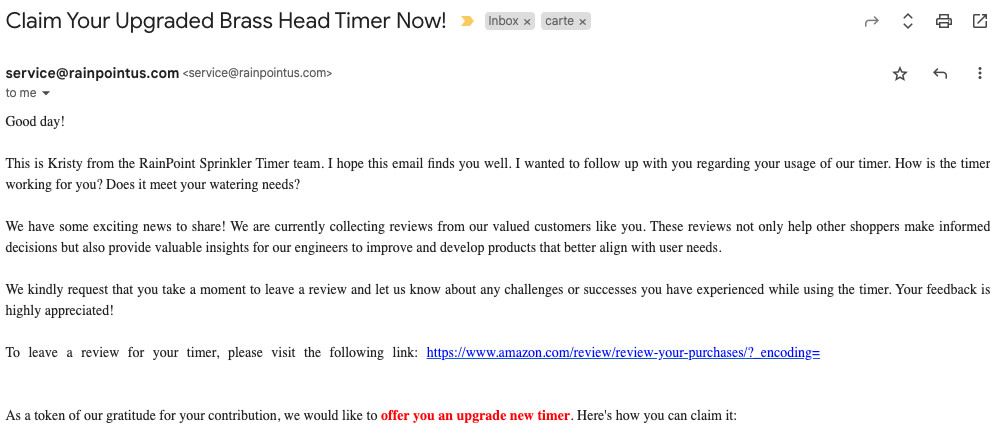
Did I like my watering timer enough to leave it five stars? Yes. Would I have left a review if I didn't have the prospect of getting another free one for doing it? No. What RainPoint understood is that authentic reviews from satisfied customers are worth their weight in digital outdoor faucet apparatuses.
If I hated the timer, obviously a free one wouldn't have changed my mind, so I wouldn't have left a dishonest five-star review. RainPoint's hope is that for the production cost of a handful of products, it can get enough positive reviews to beat competitors in Amazon's algorithm and sell to new customers on the strength of an impressive near-five-star product rating over thousands of reviews. It also makes past buyers like me more likely to buy more of its products (which I have).
13. Social engagement
A theme that's popped up among many of these strategies is the value of authentic end-user experiences, and social engagement—as opposed to paid social media advertisements—is another way to promote that. Because, when it's done well, social media breaks down the barrier between customers and corporations.
As content channels, your social media feeds can be outlets for promoting thought leadership while also driving traffic to your blog or directly to your product pages. They can also serve as branding opportunities to grow your reach to new customers if your channels provide real value in the form of useful information, discount codes, giveaways, updates on your products, or pure entertainment.
Here's Beyond Meat illustrating what I mean.
Because this is what heroes do: goes on to inconvenience a minimum wage grocery store employee https://t.co/V6u0AS8a5A
— Beyond Meat (@BeyondMeat) May 15, 2023
Beyond Meat stays top of mind to its customers while coming across as personable, empathetic, and aligned with their own values, which makes those potential customers want to continue buying its products. Followers may also feel compelled to share its funny tweets on their own feeds, expanding the potential customer base further.
Measure success by calculating customer acquisition cost
Once you've picked your customer acquisition channels and executed your customer acquisition strategies on those channels, there's still more you can do. The key to effective customer acquisition is measuring the success of your campaigns in real dollar amounts.
To do that, you can repurpose a standardized marketing equation that breaks down to spend over acquisitions. This gives you the cost per acquisition.
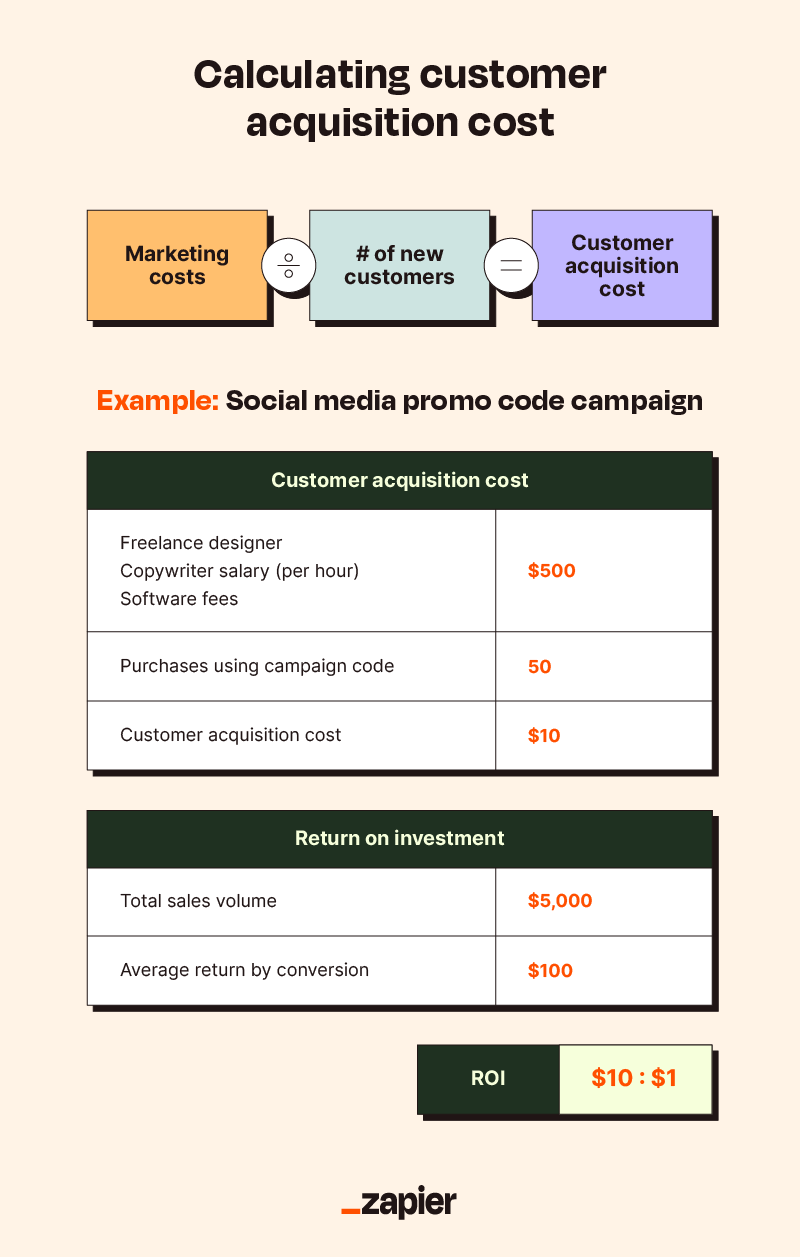
Let's say your expenses on social media combine a freelance designer's pay, your copywriter's salary (adjusted for the time they took to work on the campaign), and relevant monthly software fees, coming out to $500 for a four-week campaign. The campaign funnels through a dedicated product code, which is used 50 times. That means each customer costs you $10 to acquire.
Now, let's say the average spend through that product code is $100. That means you've generated $10 per $1 of marketing spend, while the total campaign generated $5,000 on a $500 investment.
Whether that's successful on your terms depends on your goals for the campaign. With real dollar values in hand, you can decide whether this approach is worth doubling down on later, abandoning, or tweaking before you try again.
How to keep customer acquisition costs down
Once you know the quantitative performance of your customer acquisition strategies, you can maximize your return by making your campaigns more efficient. Then, once you can get maximum value at minimum cost per acquisition, you're ready to grow your efforts.
To improve acquisition efficiency, you can either increase conversion rates, lower the cost per conversion, or increase the average value of each conversion. Here are a few common strategies for making one or more of the above happen.
Automation: Automating easily replicable marketing operations like follow-up messaging, new lead alerts, reporting, and data cleanup keeps overhead down.
A/B testing: Testing minor changes to marketing elements like copy, images, keyword focus, message timing, email layout, and acquisition channels allows you to focus efforts on what works best for your customers.
Customer segmentation: Identify different segments within your target audience and tailor your marketing efforts to each segment. This increases the relevance of your campaigns and cuts down on wasteful spending.
Offer add-on perks: By giving leads more options to increase their spend at the time of conversion (via cross-selling and upselling), you can grow the average value per conversion.
After new customer acquisition comes retention
Customer acquisition is an ongoing process—it takes continued effort to keep improving over time, and it doesn't stop when the lead clicks "Buy." The real goal for new customers is that they continue on to be retained customers, driving more value as you continue bringing new ones into the fold.
Customer retention requires its own set of strategies separate from broader acquisition strategies, but it's still a vital part of the customer acquisition process as a whole. Retained customers raise your bottom line while also helping you bring in new ones through referral programs, word-of-mouth advertising, and reviews.
Learn more about how to automate customer retention.
Automate your customer acquisition strategies
Customer acquisition is a moving target. There are always ways to improve lead volume, conversion rates, and conversion value. And what works for one product at one time may not work for a different product or even for the same product by this time next year. Even when you're satisfied, you have to stay fluid with your market.
To give you the bandwidth to focus on those strategies, you can let automation and AI handle the work that's meant for computers. Here are some guides to automating various customer acquisition channels:
